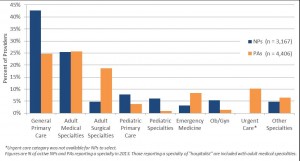Comparison of Specialty Distribution of Nurse Practitioners and Physician Assistants in North Carolina, 1997-2013 (2013-14)

Percent active North Carolina nurse practitioners (NPs) and physician assistants (PAs) by area of practice, 2013
Authors:Perri Morgan, PhD, PA-C; Anna Johnson, PhD, MSPH; Erin Fraher, PhD, MPP
Background:As healthcare demand in the United States is expected to grow, increased use of nurse practitioners (NPs) and physician assistants (PAs) is seen as a partial solution to potential physician shortages. NPs and PAs can change specialties throughout their careers and may constitute a flexible reservoir of health professionals to meet emerging healthcare needs. This project studied changes in NP and PA specialty distribution in North Carolina between 1997 and 2013.
Key Findings:Results show that both professions more than tripled in size between 1997 and 2013, growing much faster than either the state’s population or the number of practicing physicians. Due to this rapid growth, absolute numbers of NPs and PAs increased in most medical specialties. Both NPs and PAs reported practice in a wide range of medical specialties, but there were patterns specific to each profession. Over the time period studied, the proportion of PAs –but not NPs– reporting practice in primary care dropped significantly. PAs were more likely than NPs to report practice in urgent care, emergency medicine, and surgical subspecialties. The proportion of NPs practicing in obstetrics/gynecology and pediatrics also fell, while the proportion practicing in adult medical subspecialties grew. Overall, the findings indicate that the NPs and PAs practice in a wide variety of specialties and their specialty distribution in the workforce can change relatively quickly.
Policy relevance:
1) Nurse practitioners and Physician Assistants are a flexible workforce that the nation can draw upon to meet emerging healthcare needs.
2) There are important similarities and differences between NPs and PAs that should be considered in workforce policy design.
3) Future research should advance understanding of mutable individual, educational, professional, and system level factors affecting specialty choice among NPs and PAs.
4) Policies to attract NPs and PAs to specialties where they are most needed should be developed, tested, and implemented.
Methods: The study analyzed self-reported specialty for active, licensed NPs and PAs practicing in NC in 1997 and 2013. We used 1997 and 2013 licensure data for NPs and PAs from the NC Health Professions Data System, which were derived from the NC Board of Nursing and NC Medical Board.
- Fraher E, Morgan P and Johnson A. A Comparison of the Specialty Distribution of NPs and PAs in North Carolina 1997-2013. Journal of the American Academy of Physician Assistants. 2016; 29(4):38-43.
- Morgan P, Johnson A, Fraher EP. Comparison of Specialty Distribution of Nurse Practitioners and Physician Assistants in North Carolina, 1997-2013. Research Brief. March 2015.
- Morgan P, Johnson A, Fraher EP. Comparison of Specialty Distribution of Nurse Practitioners and Physician Assistants in North Carolina, 1997-2013. Presentation, AAMC Health Workforce Research Conference. May 1, 2015. Washington, DC.
- Johnson A, Morgan P, Fraher E. Comparison of Specialty Distribution of Nurse Practitioners and Physician Assistants in North Carolina, 1997-2013. Poster. AcademyHealth Annual Research Meeting. June 15, 2015. Minneapolis, MN.
You must be logged in to post a comment.